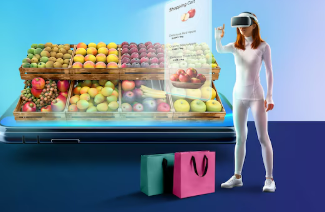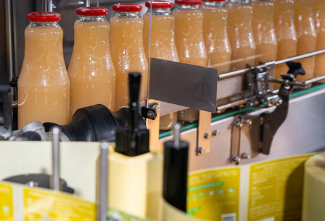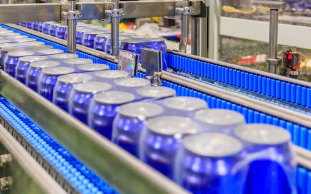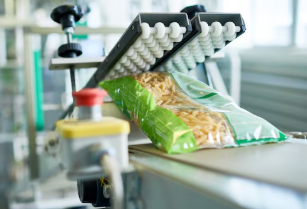YOLO in FMCG is reshaping how quality control is approached in manufacturing. With the growing demand for consistency and speed, traditional manual inspections often fall short, leading to human error and delays. YOLO, a real-time object detection technology, offers a solution by automating the inspection process. This innovative tool ensures faster, more accurate detection of product defects, reducing reliance on human checks. Let’s take a closer look at how YOLO in FMCG is transforming automated quality control and improving product consistency across production lines.
What is YOLO?

YOLO (You Only Look Once) is a fast, real-time technology that detects objects in images or videos. Instead of looking at an image in pieces, it analyzes the whole image at once, identifying multiple objects quickly and accurately. This makes it ideal for situations like automated quality control, where speed and precision are critical. YOLO is widely used in security, self-driving cars, and manufacturing to automatically find and classify objects in a single step.
YOLO revolutionized object detection by introducing a single-stage architecture, eliminating the slow processing times of multi-stage models and enabling real-time performance. Unlike traditional methods, YOLO processes the entire image in one pass, making it much faster and more efficient. This speed makes YOLO ideal for applications requiring quick decisions, such as self-driving cars, surveillance systems, and robotics, where rapid responses are essential.
As YOLO has advanced, it has added more complex methods to improve both speed and accuracy. Early versions like YOLOv1 relied on simple grid-based predictions, but newer versions have brought in innovations like anchor boxes, better feature extraction, and multi-scale detection, which boosted performance. Later updates like YOLOv4 and YOLOv5 further refined the design with advanced techniques such as cross-stage partial networks (CSPNet) and path aggregation networks (PANet), striking a balance between speed and precision. These improvements make YOLO versatile, capable of tackling various real-world object detection challenges. To learn more about the versions of YOLO, you can CLICK HERE.
Why YOLO object detection is faster?

YOLO improves speed by processing the whole image simultaneously, unlike traditional models that inspect parts of the image. It breaks the image into smaller sections, predicting both the objects and their locations in a single pass. This allows YOLO to handle multiple objects at once, making the detection process much faster. Consequently, YOLO detects objects up to 100 times more quickly than older methods, which is why it’s well-suited for real-time applications.
Here’s a simplified breakdown of why YOLO is faster:
Single-Pass Processing: YOLO analyzes the whole image at once, quickly predicting objects and their locations. In an FMCG production line, YOLO can quickly analyze a full image of packaged products in a single step, instantly identifying defective packages without needing to scan in stages.
Grid-Based Detection: The image is divided into smaller cells, making the process more efficient. YOLO divides the image into smaller sections, and each section is responsible for detecting specific objects. For example, one section might focus on identifying label defects, while another detects misaligned packaging.
Parallel Predictions: YOLO predicts multiple objects in one go, unlike models that analyze objects step by step. YOLO predicts multiple defects at once, such as identifying both damaged labels and misprints on packaging in one go, as opposed to older methods that might inspect each defect one at a time.
How does YOLO work?

In traditional models, image classification and object detection are distinct tasks. Image classification assigns a single label to the entire image, whereas YOLO detects multiple objects and identifies their exact positions in an image or video.
Here’s how YOLO works:
Input: YOLO takes an image of a production line showing packaged products moving by.
Grid Division: The image is divided into sections, where each section checks a specific area of the packages for defects, like label damage or misalignment.
Bounding Box Prediction: Each section predicts the location of defects, such as the coordinates (x, y) of a damaged label, its width, height, and the confidence that it’s a defect.
Filtering: If two sections predict similar defects, YOLO removes the duplicate predictions, keeping the most reliable one with the highest confidence score.
Final Output: The system displays the defective packages, with bounding boxes around the identified issues, such as damaged packaging or missing labels.
This process allows YOLO in FMCG to work fast, making it perfect for other real-time applications too like security systems and industrial automation.
How YOLO is revolutionizing quality control in FMCG

YOLO in FMCG is transforming quality control by enabling real-time, automated defect detection on production lines. Traditionally, manufacturers relied on manual inspections, which were not only time-consuming but also prone to human error. YOLO in FMCG changes this by processing images quickly and efficiently, detecting issues like packaging flaws, missing labels, or improper seals almost instantly.
For example, in a fast-moving consumer goods (FMCG) factory, products on a conveyor belt are continuously monitored by YOLO’s object detection system. It divides the image into grids, where each grid is responsible for detecting defects in that section of the product. If, say, a package is improperly sealed or the label is misaligned, YOLO highlights the issue with a bounding box, alerting workers immediately for quick action.
This approach not only speeds up the inspection process but also reduces waste and ensures high-quality products. By minimizing reliance on manual labor, YOLO in FMCG allows for consistent product quality at faster production speeds, ultimately improving operational efficiency and customer satisfaction.
Key benefits of YOLO for automated inspections in FMCG

YOLO in FMCG brings significant advantages to automated inspections, particularly within production lines and packaging processes. Here’s how it adds value:
Speed and Efficiency: YOLO’s real-time object detection allows for rapid scanning of products as they move along production lines, instantly identifying defects in packaging or labeling. This speeds up quality control, reducing the time it takes to spot issues and making sure production doesn’t slow down.
Improved Accuracy: Unlike manual inspections, which are prone to human error, YOLO provides consistent, precise defect detection. It can quickly identify small defects like incorrect labels, damaged packaging, or product misalignments, which ensures higher quality standards in the final products.
Cost Reduction: By automating the inspection process, YOLO in FMCG eliminates the need for manual checks, reducing labor costs and minimizing errors that could lead to waste or product recalls. This not only saves money but also improves production efficiency.
Scalability and Flexibility: YOLO can easily adapt to various FMCG production environments, from beverage packaging to food containers, ensuring its effectiveness across different product types. Its ability to scale with increasing production volumes makes it an ideal solution for high-speed manufacturing processes.
By integrating YOLO in FMCG production lines, manufacturers can ensure consistent product quality, reduce costs, and keep up with the growing demands of the industry.
The biggest challenges and how YOLO in FMCG solves them

The FMCG industry is facing some of its toughest challenges yet. From navigating an explosion of data to meeting the ever-growing demand for sustainability, brands must innovate faster than ever. As consumer expectations shift, manufacturers are looking for ways to stay competitive and maintain high-quality standards. In this ever-evolving landscape, YOLO in FMCG is stepping up as a transformative tool that can help manufacturers stay ahead of the curve.
Big Data: In an era of overwhelming data, it’s hard to focus on what matters. YOLO in FMCG helps by providing real-time, relevant insights focused on quality control. By spotting defects instantly, it eliminates irrelevant data and enables manufacturers to make swift, informed decisions.
Social Media: In today’s world, a single mistake can go viral. YOLO in FMCG ensures that only defect-free products leave the production line, protecting the brand from negative attention and potential recalls.
Online Grocery Shopping: With e-commerce growing, product consistency is essential. YOLO in FMCG guarantees that every product, whether purchased online or in-store, meets the same high-quality standards, offering customers a reliable shopping experience.
Environment & Sustainability: As sustainability becomes more critical, reducing waste is a priority. YOLO in FMCG prevents unnecessary waste by identifying defects early, ensuring only high-quality products are packaged, thereby lowering the environmental impact.
Ageing Demographic: An older consumer base demands higher product quality. YOLO in FMCG ensures that products are impeccably packaged and defect-free, meeting the expectations of both older and younger consumers, while boosting brand trust and loyalty.
How to Use YOLO object detection for defect monitoring in FMCG

Gather Data: Start by collecting images of both defect-free and defective products from your production line. The more varied your data, the more accurately the model can learn to detect issues.
Label Defects: Highlight the defective areas within the images, marking defects such as cracks, packaging flaws, or misprints. This step teaches the model what constitutes a defect.
Choose the Right YOLO Version: Select a YOLO version based on factors like the speed and accuracy you need for your FMCG production line, as well as the available computing power.
Train the Model: Feed the labeled data into the YOLO model, allowing it to learn to identify the defects across the images.
Test the Model: Run tests to evaluate how accurately the model detects defects in real-time. Make necessary adjustments to improve performance.
Deploy: Implement the trained YOLO model on your FMCG production line, where it can continuously monitor products for defects during manufacturing.
Continuous Improvement: Regularly monitor the system’s performance and update it with new data to adapt to product variations and improve detection accuracy over time.
Challenges of implementing YOLO in FMCG production lines

Detecting Small Objects: YOLO in FMCG may struggle to identify tiny defects, such as minor cracks on packaging or small contaminants in food products, potentially leading to missed quality issues.
Crowded Production Lines: When multiple items are packed closely together on conveyor belts, YOLO’s detection accuracy can drop, making it harder to distinguish individual products.
Odd-Shaped Items: FMCG products vary in shape, from irregular snack packs to uniquely molded bottles. YOLO may require fine-tuning to recognize these variations accurately.
Lighting Conditions: Shadows and reflections can distort defect detection. Proper lighting setups or camera adjustments are necessary to maintain accuracy.
False Alarms: Overly sensitive YOLO models may flag normal products as defective. Calibration is needed to reduce false positives while still catching real issues.
Hardware and Processing Constraints: Real-time YOLO implementation requires strong computing power, which can be challenging for some FMCG production setups.
Best practices for using YOLO in FMCG quality control

Define Clear Objectives: Determine which defects or inconsistencies you want YOLO in FMCG to detect, such as packaging misprints, damaged goods, or missing labels.
Use High-Quality Training Data: Ensure your dataset includes images from actual FMCG production environments to improve detection accuracy.
Expand the Dataset: Create variations of existing images—adjusting lighting, angles, and product positioning—to make YOLO more adaptable.
Fine-Tune Model Parameters: Adjust settings like confidence thresholds and anchor boxes to suit specific FMCG quality control needs.
Regularly Update the Model: Continuously retrain YOLO with new production data to maintain accuracy as products and packaging evolve.
Integrate with Other Systems: Combine YOLO with sensors, barcode scanners, or AI-driven analytics for a more robust quality control process.
Optimize your FMCG quality control with intelligent automation

Ensuring consistent product quality in FMCG manufacturing is no easy task, but AI-driven solutions like YOLO make it more efficient and reliable. If you’re looking to enhance your automated quality control system and streamline product inspections, our team at Hashed Analytic can help.
[Click here] to explore our use cases and learn how Hashed Analytic has optimized product inspection for real-world businesses. Curious about how YOLO can enhance your FMCG strategy? We’d love to hear your thoughts and explore possibilities together. Fill out the form on our homepage, and we’ll be in touch!

